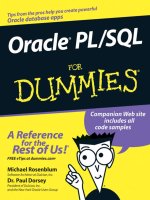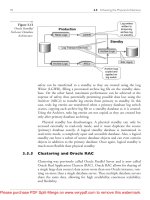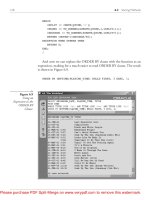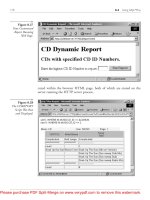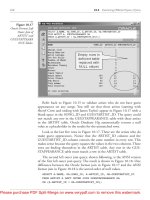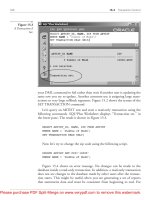Oracle SQL Jumpstart with Examples doc
Bạn đang xem bản rút gọn của tài liệu. Xem và tải ngay bản đầy đủ của tài liệu tại đây (11.73 MB, 499 trang )
Oracle Data Warehouse
Tuning for 10
g
Oracle Data Warehouse
Tuning for 10
g
Gavin Powell
Amsterdam • Boston • Heidelberg • London • New York • Oxford
Paris • San Diego• San Francisco • Singapore • Sydney • Tokyo
Elsevier Digital Press
30 Corporate Drive, Suite 400, Burlington, MA 01803, USA
Linacre House, Jordan Hill, Oxford OX2 8DP, UK
Copyright © 2005, Elsevier Inc. All rights reserved.
No part of this publication may be reproduced, stored in a retrieval system, or
transmitted in any form or by any means, electronic, mechanical, photocopying,
recording, or otherwise, without the prior written permission of the publisher.
Permissions may be sought directly from Elsevier’s Science & Technology Rights
Department in Oxford, UK: phone: (+44) 1865 843830, fax: (+44) 1865 853333,
e-mail: You may also complete your request on-line
via the Elsevier homepage (), by selecting “Customer Support”
and then “Obtaining Permissions.”
Recognizing the importance of preserving what has been written, Elsevier prints its
books on acid-free paper whenever possible.
Library of Congress Cataloging-in-Publication Data
Application Submitted.
British Library Cataloguing-in-Publication Data
A catalogue record for this book is available from the British Library.
ISBN-13: 978-1-55558-335-4
ISBN-10: 1-55558-335-0
For information on all Elsevier Digital Press publications visit our Web site at
www.books.elsevier.com
05 06 07 08 09 10 9 8 7 6 5 4 3 2 1
v
Contents at a Glance
Preface xix
Introduction to Data Warehousing xxiii
Part I: Data Warehouse Data Modeling 1
1
The Basics of Data Warehouse Data Modeling 3
2
Introducing Data Warehouse Tuning 31
3
Effective Data Warehouse Indexing 49
4
Materialized Views and Query Rewrite 79
5
Oracle Dimension Objects 113
6
Partitioning and Basic Parallel Processing 137
Part II: Tuning SQL Code in a Data Warehouse 161
7
The Basics of SQL Query Code Tuning 163
8
Aggregation Using GROUP BY Clause Extensions 215
9
Analysis Reporting 249
10
Modeling with the MODEL Clause 281
Part III: Advanced Topics 317
11
Query Rewrite 319
12
Parallel Processing 335
13
Data Loading 351
14
Data Warehouse Architecture 385
A
New Data Warehouse Features in Oracle Database 10g 423
B.
Sample Schemas 425
C.
Sample Scripting 431
D.
Syntax Conventions 447
E.
Sources of Information 449
Index 451
vii
Contents
Preface xix
Introduction to Data Warehouse Tuning xxiii
Part I: Data Warehouse Data Modeling 1
1 The Basics of Data Warehouse Data Modeling 3
1.1 The Relational and Object Data Models 3
1.1.1 The Relational Data Model 4
Normalization 4
1st Normal Form 4
2nd Normal Form 4
3rd Normal Form 4
4th Normal Form 5
5th Normal Form 6
Referential Integrity 6
Surrogate Keys 7
Denormalization 7
Data Warehouses—Why Not the Relational Model? 10
1.1.2 The Object Data Model 10
Data Warehouses—Why Not the Object Model? 12
1.1.3 The Object-Relational Data Model 13
1.2 Data Modeling for Data Warehouses 13
1.2.1 The Container Shipment Tracking Schema 13
1.2.2 The Dimensional Data Model 15
What Is a Star Schema? 18
What Is a Snowflake Schema? 19
1.2.3 Data Warehouse Data Model Design Basics 21
Dimension Entities 22
viii Contents
Dimension Entity Types 22
Fact Entities 24
Fact Entity Types 25
Granularity, Granularity, and Granularity 26
Time and How Long to Retain Data 27
Other Factors to Consider During Design 27
Surrogate Keys 27
Duplicating Surrogate Keys and
Associated Names 27
Referential Integrity 28
Managing the Data Warehouse 28
2 Introducing Data Warehouse Tuning 31
2.1 Let’s Build a Data Warehouse 31
2.1.1 The Demographics Data Model 31
2.1.2 The Inventory-Accounting OLTP Data Model 32
2.1.3 The Data Warehouse Data Model 34
Identify the Facts 34
Identify the Granularity 35
Identify and Build the Dimensions 35
Build the Facts 36
2.2 Methods for Tuning a Data Warehouse 37
2.2.1 Snowflake versus Star Schemas 37
Star Schemas 39
What Is a Star Query? 40
Star Transformation 40
Using Bitmap Indexes 43
Snowflake Schemas 43
Introducing Oracle Database Dimension
Object Hierarchies 44
2.2.2 3rd Normal Form Schemas 44
2.2.3 Introducing Other Data Warehouse Tuning Methods 44
3 Effective Data Warehouse Indexing 49
3.1 The Basics of Indexing 49
3.1.1 The When and What of Indexing 50
Referential Integrity Indexing 51
Surrogate Keys 52
Views and View Constraints in Data Warehouses 53
Alternate Indexing 53
Contents ix
Contents
3.1.2 Types of Indexes in Oracle Database 54
BTree Indexes 55
Types of BTree Indexes 56
Unique BTree Index 56
Ascending or Descending BTree Index 56
Sorted or Unsorted BTree Index 57
Function-Based BTree Index 57
Reverse Key Value BTree Index 58
Compressed Composite Column BTree Index 58
Bitmap Indexes 58
Bitmap Index Cardinality 58
Bitmap Performance 60
Bitmap Block Level Locking 60
Bitmap Composite Column Indexes 60
Bitmap Index Overflow 60
Bitmap Index Restrictions 60
Bitmap Join Indexes 61
Other Types of Indexing 61
3.2 Star Queries and Star Query Transformations 62
3.2.1 Star Queries 62
3.2.2 Star Transformation Queries 69
Bitmap Join Indexes 70
3.2.3 Problems with Star Queries and Star Transformations 73
3.3 Index Organized Tables and Clusters 75
4 Materialized Views and Query Rewrite 79
4.1 What Is a Materialized View? 79
4.1.1 The Benefits of Materialized Views 80
Related Objects 81
4.1.2 Potential Pitfalls of Materialized Views 81
4.2 Materialized View Syntax 82
4.2.1 CREATE MATERIALIZED VIEW 82
The REFRESH Clause 82
ENABLE QUERY REWRITE 85
What Is Query Rewrite? 85
Verifying Query Rewrite 86
Query Rewrite Restrictions 86
Improving Query Rewrite Performance 86
ON PREBUILT TABLE 87
Registering Existing Materialized Views 87
Compression 87
x Contents
Other Syntax Options 88
4.2.2 CREATE MATERIALIZED VIEW LOG 88
The WITH Clause 89
The SEQUENCE Clause 90
4.2.3 ALTER MATERIALIZED VIEW [LOG] 90
4.2.4 DROP MATERIALIZED VIEW [LOG] 90
4.3 Types of Materialized Views 91
4.3.1 Single Table Aggregations and Filtering Materialized Views 91
Fast Refresh Requirements for Aggregations 93
4.3.2 Join Materialized Views 94
Fast Refresh Requirements for Joins 97
Joins and Aggregations 97
4.3.3 Set Operator Materialized Views 98
4.3.4 Nested Materialized Views 98
4.3.5 Materialized View ORDER BY Clauses 102
4.4 Analyzing and Managing Materialized Views 102
4.4.1 Metadata Views 102
4.4.2 The DBMS_MVIEW Package 104
Verifying Materialized Views 104
Estimating Materialized View Storage Space 105
Explaining a Materialized View 105
Explaining Query Rewrite 106
Manual Refresh 107
Miscellaneous Procedures 108
4.4.3 The DBMS_ADVISOR Package 108
4.5 Making Materialized Views Faster 109
5 Oracle Dimension Objects 113
5.1 What Is a Dimension Object? 113
The Benefits of Implementing Dimension Objects 114
Negative Aspects of Dimension Objects 116
5.2 Dimension Object Syntax 116
5.2.1 CREATE DIMENSION Syntax 117
Level Clause 117
Hierarchy Clause 119
Dimension Join Clause 120
Attribute Clause 122
Extended Attribute Clause 123
5.2.2 ALTER and DROP DIMENSION Syntax 123
5.2.3 Using Constraints with Dimensions 123
5.3 Dimension Object Metadata 124
Contents xi
Contents
5.4 Dimension Objects and Performance 125
5.4.1 Rollup Using Dimension Objects 127
5.4.2 Join Back Using Dimension Objects 132
6 Partitioning and Basic Parallel Processing 137
6.1 What Are Partitioning and Parallel Processing? 137
6.1.1 What Is Partitioning? 137
6.1.2 The Benefits of Using Partitioning 138
6.1.3 Different Partitioning Methods 139
Partition Indexing 140
When to Use Different Partitioning Methods 141
6.1.4 Parallel Processing and Partitioning 143
6.2 Partitioned Table Syntax 144
6.2.1 CREATE TABLE: Range Partition 144
6.2.2 CREATE TABLE: List Partition 146
6.2.3 CREATE TABLE: Hash Partition 147
6.2.4 Composite Partitioning 148
CREATE TABLE: Range-Hash Partition 148
CREATE TABLE: Range-List Partition 149
6.2.5 Partitioned Materialized Views 151
6.3 Tuning Queries with Partitioning 153
6.3.1 Partitioning EXPLAIN PLANs 153
6.3.2 Partitioning and Parallel Processing 154
6.3.3 Partition Pruning 154
6.3.4 Partition-Wise Joins 155
Full Partition-Wise Joins 155
Partial Partition-Wise Joins 157
6.4 Other Partitioning Tricks 158
6.5 Partitioning Metadata 158
Part II: Tuning SQL Code in a Data Warehouse 161
7 The Basics of SQL Query Code Tuning 163
7.1 Basic Query Tuning 163
7.1.1 Columns in the SELECT Clause 164
7.1.2 Filtering with the WHERE Clause 164
Multiple Column WHERE Clause Filters 166
7.1.3 Aggregating 169
How to Use the HAVING Clause 169
7.1.4 Using Functions 170
xii Contents
7.1.5 Conditions and Operators 172
Comparison Conditions 172
Equi, Anti, and Range 173
LIKE Pattern Matching 173
Set Membership (IN and EXISTS) 174
Using Subqueries for Efficiency 174
Groups 175
Logical Operators 175
Set Operators 176
7.1.6 Pseudocolumns 176
Sequences 176
The ROWID Pseudocolumn 177
The ROWNUM Pseudocolumn 178
7.1.7 Joins 179
How to Code Joins in SQL Code 179
How Oracle Joins Tables 181
How to Tune a Join 183
7.2 How Oracle SQL Is Executed 184
7.2.1 The Parser 184
7.2.2 The Optimizer 185
The Importance of Statistics 186
Realistic Statistics 186
Dynamic Sampling 187
Overriding the Optimizer Using Hints 187
Classifying Hints 188
Influence the Optimizer 189
Change Table Scans 189
Change Index Scans 189
Change Joins 190
Parallel SQL 190
Changing Queries and Subqueries 190
7.3 Tools for Tuning Queries 191
7.3.1 What Is the Wait Event Interface? 192
The System Aggregation Layer 192
Idle Events 196
The Session Layer 199
The Third Layer and Beyond 206
7.3.2 Oracle Database Wait Event
Interface Improvements 208
7.3.3 Oracle Enterprise Manager and the Wait
Event Interface 209
Contents xiii
Contents
8 Aggregation Using GROUP BY
Clause Extensions 215
8.1 What Are GROUP BY Clause Extensions? 215
8.1.1 Why Use GROUP BY Clause Extensions? 215
8.2 GROUP BY Clause Extensions 216
8.2.1 The ROLLUP and CUBE Clauses 217
The ROLLUP Clause 217
ROLLUP Clause Syntax 217
How the ROLLUP Clause Helps Performance 217
The CUBE Clause 222
CUBE Clause Syntax 223
How the CUBE Clause Helps Performance 223
The Multiple Dimensions of the CUBE Clause 225
8.2.2 The GROUPING SETS Clause 225
GROUPING SETS Clause Syntax 227
How the GROUPING SETS Clause Helps Performance 227
8.2.3 Grouping Functions 232
The GROUPING Function 232
The GROUPING_ID Function 234
The GROUP_ID Function 234
8.3 GROUP BY Clause Extensions and
Materialized Views 235
8.4 Combining Groupings Together 242
8.4.1 Composite Groupings 243
8.4.2 Concatenated Groupings 245
8.4.3 Hierarchical Cubes 246
9 Analysis Reporting 249
9.1 What Is Analysis Reporting? 249
9.1.1 How Does Analysis Reporting
Affect Performance? 251
9.2 Types of Analysis Reporting 251
9.3 Introducing Analytical Functions 253
9.3.1 Simple Summary Functions 253
9.3.2 Statistical Function Calculators 253
9.3.3 Statistical Distribution Functions 254
9.3.4 Ranking Functions 255
9.3.5 Lag and Lead Functions 255
9.3.6 Aggregation Functions Allowing Analysis 256
9.4 Specialized Analytical Syntax 256
xiv Contents
9.4.1 The OVER Clause 256
The ORDER BY Clause 257
The PARTITION BY Clause 257
The Windowing Clause 260
9.4.2 The WITH Clause 262
9.4.3 CASE and Cursor Expressions 266
CASE Expressions 266
Cursor Expressions 270
9.5 Analysis in Practice 270
9.5.1 Rankings and Ratios 271
9.5.2 Lead and Lag Functionality 275
9.5.3 Histograms 275
9.5.4 Other Statistical Functionality 277
9.5.5 Data Densification 277
10 Modeling with the MODEL Clause 281
10.1 What Is the MODEL Clause? 281
10.1.1 The Parts of the MODEL Clause 281
10.1.2 How the MODEL Clause Works 283
10.1.3 Better Performance Using the MODEL Clause 286
10.2 MODEL Clause Syntax 288
10.2.1 Cell References 288
10.2.2 Return Rows 289
10.2.3 The Main Model 289
Rules 290
Assigning Cell Values 291
10.2.4 MODEL Clause Functions 291
10.3 What Can the MODEL Clause Do? 292
10.3.1 Materialized Views and the MODEL Clause 292
10.3.2 Referencing Cells 295
10.3.3 Referencing Multiple Models 301
10.3.4 UPDATE versus UPSERT 306
10.3.5 Loops 308
10.4 Performance and the MODEL Clause 308
10.4.1 Parallel Execution 308
10.4.2 Understanding MODEL Clause Query Plans 313
Contents xv
Contents
Part III: Advanced Topics 317
11 Query Rewrite 319
11.1 What Is Query Rewrite? 319
11.1.1 When Does the Optimizer Query Rewrite? 320
11.1.2 What Can the Optimizer Query Rewrite? 320
11.2 How the Optimizer Rewrites Queries 321
11.2.1 Matching Entire Query Strings 321
11.2.2 Matching Pieces of Queries 324
Join Back 324
Dimensional Rollups 325
Aggregation 327
Filters 328
11.2.3 Special Cases for Query Rewrite 330
11.3 Affecting Query Rewrite Performance 331
12 Parallel Processing 335
12.1 What Is Parallel Processing? 335
12.1.1 What Can Be Executed in Parallel? 336
12.2 Degree of Parallelism (Syntax) 336
12.3 Configuration Parameters 337
12.4 Demonstrating Parallel Execution 339
12.4.1 Parallel Queries 339
12.4.2 Index DDL Statements 343
12.4.3 SELECT Statement Subqueries 344
12.4.4 DML Statements 345
12.4.5 Partitioning Operations 346
12.5 Performance Views 346
12.6 Parallel Execution Hints 348
12.7 Parallel Execution Query Plans 348
13 Data Loading 351
13.1 What Is Data Loading? 351
13.1.1 General Loading Strategies 352
Single Phase Load 352
Multiple Phase Load 353
An Update Window 354
The Effect of Materialized Views 354
Oracle Database Loading Tools 354
xvi Contents
13.2 Extraction 355
13.2.1 Logical Extraction 355
13.2.2 Physical Extraction 355
13.2.3 Extraction Options 356
Dumping Files Using SQL 356
Exports 359
External Tables 359
Other Extraction Options 361
13.3 Transportation Methods 361
13.3.1 Database Links and SQL 362
13.3.2 Transportable Tablespaces 363
Transportable Tablespace Limitations 365
Self-Containment 365
Transporting a Tablespace 367
13.4 Loading and Transformation 368
13.4.1 Basic Loading Procedures 369
SQL*Loader 369
SQL*Loader Performance Characteristics 369
SQL*Loader Architecture 370
Input Datafiles 371
The SQL*Loader Control File 372
Row Loading Options 372
Loading Multiple Tables 373
Field Definitions 373
Dealing with NULL Values 376
Load Filters 377
Unwanted Columns 377
Control File Datatypes 378
Embedded SQL Statements 378
Adding Data Not in Input Datafiles 379
Executing SQL*Loader 379
The Parameter File 379
Plug-Ins 380
Partitions 380
Transportable Tablespaces 381
External Tables 382
The Import Utility 383
13.4.2 Transformation Processing 383
14 Data Warehouse Architecture 385
14.1 What Is a Data Warehouse? 385
Contents xvii
Contents
14.1.1 What Is Data Warehouse Architecture? 385
14.2 Tuning Hardware Resources for
Data Warehousing 386
14.2.1 Tuning Memory Buffers 387
14.2.2 Tuning Block Sizes 388
14.2.3 Tuning Transactions 389
14.2.4 Tuning Oracle Net Services 390
Tuning Net Services at the Server: The Listener 390
Tuning Net Services at the Client 391
14.2.5 Tuning I/O 393
Striping and Redundancy: Types of RAID Arrays 395
The Physical Oracle Database 396
How Oracle Database Files Fit Together 397
Special Types of Datafiles 398
Tuning Datafiles 398
Tuning Redo and Archive Log Files 399
Tablespaces 402
BIGFILE Tablespaces 406
Avoiding Datafile Header Contention 407
Temporary Sort Space 407
Tablespace Groups 407
Automated Undo 408
Caching Static Data Warehouse Objects 408
Compressing Objects 409
14.3 Capacity Planning 409
14.3.1 Datafile Sizes 411
14.3.2 Datafile Content Sizes 412
14.3.3 The DBMS_SPACE Package 412
14.3.4 Statistics 414
Using the ANALYZE Command 414
The DBMS_STATS Package 415
Using Statistics for Capacity Planning 415
14.3.5 Exact Column Data Lengths 419
14.4 OLAP and Data Mining 422
xviii Contents
A New Data Warehouse Features in Oracle Database 10g 423
B Sample Schemas 425
C Sample Scripting 431
D Syntax Conventions 447
E Sources of Information 449
Index 451
xix
Preface
This book focuses on tuning of Oracle data warehouse databases
. My
previous tuning book,
Oracle High Performance Tuning
for 9
i
and 10
g
(ISBN: 1555583059) focused on tuning of OLTP databases. OLTP data-
bases require fine-tuning of small transactions for very high concurrency
both in reading and changing of an OLTP database.
Tuning a data warehouse database is somewhat different to tuning of
OLTP databases. Why? A data warehouse database concentrates on large
transactions and mostly requires what is termed throughput. What is
throughput? Throughput is the term applied to the passing of large
amounts of information through a server, network, and Internet environ-
ment. The ultimate objective of a data warehouse is the production of
meaningful and useful reporting. Reporting is based on data warehouse
data content. Reporting generally reads large amounts of data all at once.
In layman’s terms, an OLTP database needs to access individual items
rapidly, resulting in heavy use of concurrency or sharing. Thus, an OLTP
database is both CPU and memory intensive but rarely I/O intensive. A
data warehouse database needs to access lots of information, all at once, and
is, therefore, I/O intensive. It follows that a data warehouse will need fast
disks and lots of them. Disk space is cheap!
A data warehouse is maintained in order to archive historical data no
longer directly required by front-end OLTP systems. This separation pro-
cess has two effects: (1) it speeds up OLTP database performance by remov-
ing large amounts of unneeded data from the front-end environment, (2)
the data warehouse is freed from the constraints of an OLTP environment
in order to provide both rapid query response and ease of adding new data
en masse to the data warehouse. Underlying structural requirements for
OLTP and data warehouse databases are different to the extent that they
can conflict with each other, severely affecting performance of both data-
base types.
xx Preface
How can data warehouse tuning be divided up?
Tuning a data ware-
house can be broken into a number of parts: (1) data modeling specific to
data warehouses, (2) SQL code tuning mostly involving queries, and (3)
advanced topics including physical architecture, data loading, and various
other topics relevant to tuning.
The objective of this book is to partly expand on the content of my
previous OLTP database tuning book, covering areas specific only to
data warehousing tuning, and duplicating some sections in order to
allow purchase of one of these two books
. Currently there is no title on the
market covering data warehouse tuning specifically for Oracle Database.
Any detail relating directly to hardware tuning or hardware architectural
tuning will not be covered in this book in any detail, apart from the content
in the final chapter. Hardware encompasses CPUs, memory, disks, and so
on. Hardware architecture covers areas such as RAID arrays, clustering with
Oracle RAC, and Oracle Automated Storage Management (ASM). RAID
arrays underlie an Oracle database and are, thus, the domain of the operat-
ing system and not the database. Oracle RAC consists of multiple clustered
thin servers connected to a single set of storage disks. Oracle ASM essen-
tially provides disk management with striping and mirroring, much like
RAID arrays and something like Veritas software would do. All these things
are not strictly directly related to tuning an Oracle database warehouse
database specifically but can be useful to help performance of underlying
architecture in an I/O intensive environment, such as a data warehouse
database.
Data warehouse data modeling, specialized SQL code, and data loading
are the most relevant topics to the grass-roots building blocks of data ware-
house performance tuning. Transformation is somewhat of a misfit topic
area since it can be performed both within and outside an Oracle database;
quite often both. Transformation is often executed using something like
Perl scripting or a sophisticated and expensive front-end tool. Transforma-
tion washes and converts data prior to data loading, allowing newly intro-
duced data to fit in with existing data warehouse structures. Therefore,
transformation is not an integral part of Oracle Database itself and, thus,
not particularly relevant to the core of Oracle Database data warehouse tun-
ing. As a result, transformation will only be covered in this book explicitly
to the extent to which Oracle Database tools can be used to help with trans-
formation processing.
As with my previous OLTP performance tuning book, the approach
in this book is to present something that appears to be immensely com-
plex in a simplistic and easy to understand manner
. This book will dem-
Preface xxi
Preface
onstrate by example, showing not only how to make something faster but
also demonstrating approaches to tuning, such as use of Oracle Partition-
ing, query rewrite, and materialized views. The overall objective is to utilize
examples to expedite understanding for the reader.
Rather than present piles of unproven facts and detailed notes of syntax
diagrams, as with my previous OLTP tuning book, I will demonstrate
purely by example. My hardware is old and decrepit, but it does work. As a
result I cannot create truly enormous data warehouse databases, but I can
certainly do the equivalent by
stressing out
some very old machines as data-
base servers.
A reader of my previous OLTP performance tuning title commented
rather harshly on Amazon.com that this was a particularly pathetic
approach and that I should have spent a paltry sum of $1,000 on a Linux
box. Contrary to popular belief writing books does not make $1,000 a pal-
try sum of money. More importantly, the approach is intentional, as it is
one of stressing out Oracle Database software and not the hardware or
underlying operating system. Thus, the older, slower, and less precise the
hardware and operating system are, the more the Oracle software itself is
tested. Additionally, the reader commented that my applications were
patched
together. Applications used in these books are not strictly applica-
tions, as applications have front ends and various sets of pretty pictures and
screens. Pretty pictures are not required in a book, such as this book. Appli-
cations in this book are scripted code intended to subject a database to all
types of possible activity on a scheduled basis. Rarely does any one applica-
tion do all that. And much like the irrelevance of hardware and operating
system, front-end screens are completely irrelevant to performance tuning
of Oracle Database software.
In short, the approach in this book, like nearly all of my other Oracle
books, is to demonstrate and write from my point of view. I myself, being
the author of this particular dissertation, have almost 20 years of experience
working in custom software development and database administration,
using all sorts of SDKs and databases, both relational and object. This book
is written by a database administrator (DBA)/developer—for the use of
DBAs, developers, and anyone else who is interested, including end users.
Once again, this book is not a set of rules and regulations, but a set of sug-
gestions for tuning stemming from experimentation with real databases.
A focused tutorial on the subject of tuning Oracle database ware-
house databases is much needed today
. There does not seem to be much
in the way of data warehouse tuning titles available, and certainly none that
focus on tuning and demonstrate from experience and purely by example.
xxii Preface
This book attempts to verify every tuning precept it presents with substan-
tive proof, even if the initial premise is incorrect. This practice will obvi-
ously have to exist within the bounds of the hardware I have in use. Be
warned that my results may be somewhat related to my insistent use of geri-
atric hardware. From a development perspective, forcing development on
slightly underperforming hardware can have the positive effect of produc-
ing better performing databases and applications in production.
People who would benefit from reading this book would be database
administrators, developers, data modelers, systems or network adminis-
trators, and technical managers
. Anyone using an Oracle Database data
warehouse would likely benefit from reading this book, particularly DBAs
and developers who are attempting to increase data warehouse database per-
formance. However, since tuning is always best done from the word Go,
even those in the planning stages of application development and data
warehouse construction would benefit from reading a book such as this.
Disclaimer Notice:
Please note that the content of this book is made avail-
able “AS IS.” I am in no way responsible or liable for any mishaps as a result
of using this information, in any form or environment.
Once again my other tuning title,
Oracle Performance Tuning for 9
i
and
10
g (ISBN: 1555583059), covers tuning for OLTP databases with occa-
sional mention of data warehouse tuning. The purpose of this book is to
focus solely on data warehouse tuning and all it entails. I have made a con-
certed effort not to duplicate information from my OLTP database tuning
book. However, I have also attempted not to leave readers in the dark who
do not wish to purchase and read both titles. Please excuse any duplication
where I think it is necessary.
Let’s get started.
xxiii
Introduction to Data Warehouse Tuning
So what is a data warehouse? Let’s begin this journey of discovery by briefly
examining the origins and history of data warehouses.
The Origin and History of Data Warehouses
How did data warehouses come about? Why were they invented? The sim-
ple answer to this question is because existing databases were being sub-
jected to conflicting requirements. These conflicting requirements are based
on operational use versus decision support use.
Operational use in Online Transaction Processing (OLTP) databases is
access to the most recent data from a database on a day-to-day basis, ser-
vicing end user and data change applications. Operational use requires a
breakdown of database access by functional applications, such as filling
out order forms or booking airline tickets. Operational data is database
activity based on the functions of a company. Generally, in an internal
company, environment applications might be divided up based on differ-
ent departments.
Decision support use, on the other hand, requires not only a more glo-
bal rather than operationally precise picture of data, but also a division of
the database based on subject matter. So as opposed to filling out order
forms or booking airline tickets interactively, a decision support user would
need to know what was ordered between two dates (all orders made
between those dates), or where and how airline tickets were booked, say for
a period of an entire year.
The result is a complete disparity between the requirements of opera-
tional applications versus decision support functions. Whenever you check
out an item in a supermarket and the bar code scanner goes beep, a single
stock record is updated in a single table in a database. That’s operational.
xxiv Separation of OLTP and Data Warehouse Databases
On the contrary, when the store manager runs a report once every month to
do a stock take and find out what and how much must be reordered, his
report reads all the stock records for the entire month. So what is the dis-
parity? Each sold item updates a single row. The report reads all the rows.
Let’s say the table is extremely large and the store is large and belongs to a
chain of stores all over the country, you have a very large database. Where
the single row update of each sale requires functionality to read individual
rows, the report wants to read everything. In terms of database performance
these two disparate requirements can cause serious conflicts. Data ware-
houses were invented to separate these two requirements, in effect separat-
ing active and historical data, attempting to remove some batch and
reporting activity from OLTP databases.
Note:
There are numerous names associated with data warehouses, such as
Inmon and Kimball. It is perhaps best not to throw names around or at
least to stop at associating them with any specific activity or invention.
Separation of OLTP and Data
Warehouse Databases
So why is there separation between these two types of databases? The
answer is actually very simple. An OLTP database requires fast turnaround
of exact row hits. A data warehouse database requires high throughput per-
formance for large amounts of data. In the old days of client server envi-
ronments, where applications were in-house within a single company only,
everyone went home at night and data warehouse batch updates and
reporting could be performed overnight. In the modern global economy of
the Internet and OLTP databases, end user operational applications are
required to be active 24/7, 365 days a year. That’s permanently! What it
means is that there is no window for any type of batch activity, because
when we are asleep in North America everyone is awake in the Far East,
and the global economy requires that those who are awake when we are
snoozing are serviced in the same manner. Thus, data warehouse activity
using historical data, be it updates to the data warehouse or reporting,
must be separated from the processing of OLTP, quick reaction concur-
rency requirements. A user will lose interest in a Web site after seven sec-
onds of inactivity.
